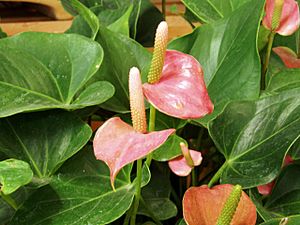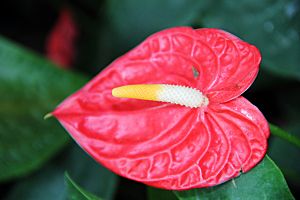Anthurium andraeanum facts for kids
Quick facts for kids Anthurium andraeanum |
|
|---|---|
 |
|
| Scientific classification | |
| Genus: |
Anthurium
|
| Species: |
andraeanum
|
| Synonyms | |
|
Anthurium venustum Sodiro |
|
Anthurium andraeanum is a beautiful flowering plant often called the flamingo flower or painter's palette. It's part of the Araceae family and originally comes from Colombia and Ecuador. This plant is super popular for its bright, waxy "flowers" that aren't actually flowers, but special leaves! It even won an award from the Royal Horticultural Society for being a great garden plant.
Contents
What's in a Name?
Plants in the Anthurium group have many fun common names. You might hear them called flamingo flower, tailflower, painter's palette, oilcloth flower, or laceleaf. The scientific name, Anthurium, comes from ancient Greek words. Anthos means "flower," and oura means "a tail." This name describes the plant's unique tail-like flower spike, called a spadix.
What Does it Look Like?
The flamingo flower is a perennial plant, which means it lives for more than two years. It's a monocotyledonous plant, a type of plant that grows from a seed with one leaf. It loves warm, shady, and humid places, like tropical rainforests.
The most special part of this plant is its brightly colored spathe. This spathe is actually a modified leaf, not a flower petal. It's often shiny and waxy, and can be red, pink, or other bright colors. Sticking out from the spathe is a long, tail-like part called the spadix. This spadix is where the plant's many tiny flowers are found.
The plant itself is usually short and stands upright. Its leaves are heart-shaped, like a cardioid or a valentine heart. They grow on long stems called petioles, which can be about 30–40 cm long.
The colorful spathe is typically 8–15 cm long. The spadix, which holds the tiny flowers, is about 7–9 cm long. It looks a bit like a candle, and can be white or yellow. The small flowers on the spadix are hermaphroditic, meaning each flower has both male and female parts. These plants can bloom all year round! After flowering, the plant produces small, fleshy berries as fruit.
Where Does it Grow?
This plant is originally from Ecuador and southwestern Colombia. But because it's so beautiful, people have planted it in many other parts of the world. You can find it growing naturally in the Caribbean and on Réunion island.
Many different types, or hybrids, of the flamingo flower are grown as ornamental plants. This means they are grown just for their beauty. They are also very popular for making flower bouquets.
Is it Safe to Touch?
It's important to know that the whole flamingo flower plant is toxic. It contains natural chemicals called saponins and tiny crystals of calcium oxalate. These crystals are like tiny needles that can cause irritation if they touch your skin or mouth.
If a small piece of the plant gets into the mouth, it can cause a lot of irritation and pain in the mouth and throat. If a person touches the plant, it might cause skin redness or even small blisters. If someone accidentally eats part of the plant, it can lead to extra salivation, trouble swallowing, and even vomiting. So, it's best to admire these plants without touching or eating them!
Gallery
-
Ანთურიუმი Anthurium Hybr. Flamingoblume.JPG
See also
 In Spanish: Anthurium andraeanum para niños
In Spanish: Anthurium andraeanum para niños






